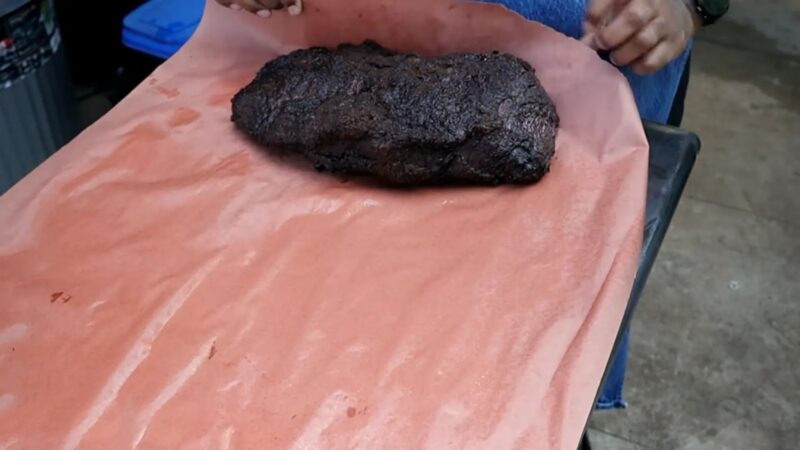As I’ve honed my craft in the art of barbecue, one question that often surfaces among my fellow enthusiasts is, “when to wrap your brisket?” It’s a pivotal step in the quest for that perfect BBQ, a turning point that can make or break the luscious texture and rich flavor profile of this cherished cut.
I’ve learned that the ideal moment to embrace your brisket with a wrap comes as it hits the infamous stall. This guide is not just about preserving moisture or speeding up cooking time; it encapsulates hard-earned BBQ techniques that elevate a simple smoked brisket into a culinary masterpiece.
Your brisket’s bark is your road map; once it reaches the perfect state of being well-set—dark brown edged with deep red—it’s timing for the wrap. A well-timed wrap, using the apt materials, is the bridge crossing the gap between a good piece of meat and an exceptional barbecue experience.
In sharing these brisket wrapping guide insights, I don’t just pass on knowledge—I pass on the tradition and passion of smoking brisket that BBQ aficionados cherish. Keep reading for a comprehensive understanding of why, when, and how to swaddle your brisket, ensuring every slice is imbued with juicy perfection.
Key Takeaways
- Identify when to wrap your brisket during the stall to overcome temperature plateaus.
- Visual cues like the bark’s texture and color are critical before wrapping.
- Wrapping helps retain moisture, accelerates the cooking process, and prevents over-smoking.
- The choice of wrapping material can significantly affect the brisket’s final taste and texture.
- Perfect BBQ is achieved with a combination of precise timing, proper technique, and patience.
Understanding the Basics of Brisket Wrapping
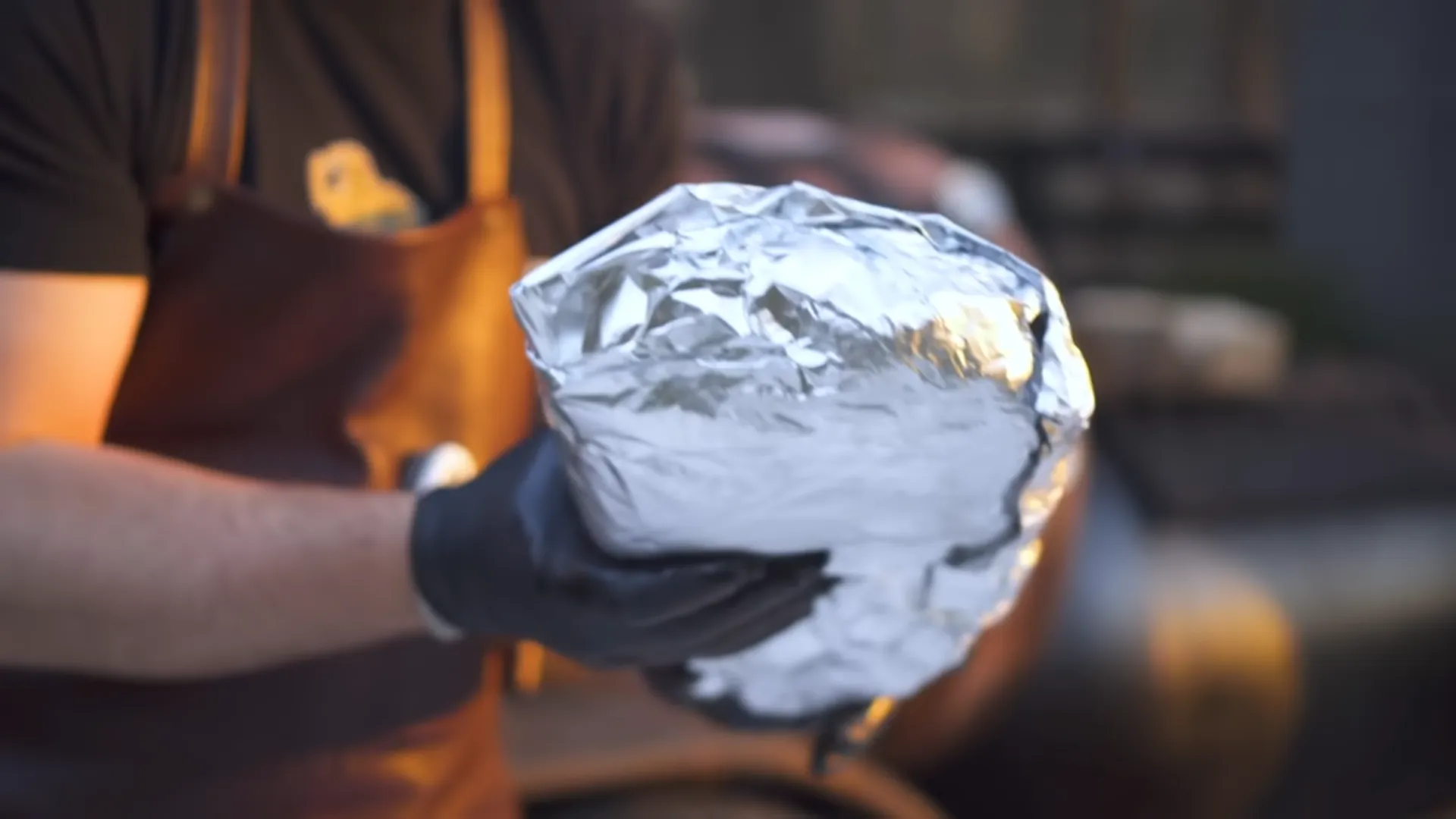
When I delve into the basics of brisket wrapping, it’s more than a mere step in the BBQ process—it’s an act of preserving the painstakingly developed flavors and ensuring the meat’s succulence. To understand why wrap your brisket, consider the brisket itself. This prime cut, known for its tough connective tissue, requires long, slow cooking to break down into tender bliss. Wrapping is not an arbitrary choice; it’s a strategic move to enhance the meat’s quality during its lengthy journey through smoke and heat.
Brisket wrapping, in essence, is about maintaining an even cooking environment and safeguarding the meat’s surface—the bark—from undesirable outcomes. This protective measure involves enveloping your brisket in a layer—typically aluminum foil or butcher paper—especially when its internal temperature hits a plateau, in the 150° to 180°F (65.6° to 82.2°C) range. This phenomenon is frequently termed ‘the stall’, and mastering brisket wrapping techniques can help you breeze through this phase.
The Role of Wrapping during the Stall
The stall—an occurrence you’ll notice when the meat’s core temperature seemingly freezes—poses a challenge, but wrapping can turn the tide. “Why wrap your brisket” at this point? Well, wrapping acts as an insulator, trapping heat and mitigating the evaporative cooling effect that defines the stall. This move makes a significant difference, allowing you to nudge the temperature upwards and resume the cooking process more efficiently.
- Counteracts evaporative cooling to beat the stall
- Enhances the efficiency of the cooking process
- Holds in moisture, preventing the brisket from drying out
- Protects the bark’s texture and flavor, a cardinal feature of excellent BBQ
Let’s break down the brisket wrapping techniques to appreciate the subtleties involved. The choice of material—foil vs. paper—impacts the outcome greatly. Foil creates a tighter seal, holding in more moisture, while paper, allowing some breathability, maintains a firmer bark. Suffice it to say, that your final decision will reflect a balance between moisture retention and bark preservation.
With wrapping, we’re not just cooking; we’re sculpting the flavor and texture profile of the brisket, one degree at a time.
| Wrapping Material | Moisture Retention | Bark Preservation |
|---|---|---|
| Aluminum Foil | High | Low – Moderate |
| Butcher Paper | Moderate | High |
When discussing the basics of brisket wrapping, it’s not merely a tactic but a meticulous form of art that stands between a simple cut of beef and a memorable piece of barbecue. Knowing why and how to tightly swaddle your brisket is essential—it’s the embrace that brings out the best in your BBQ.
Identifying the Perfect Time to Wrap Your Brisket
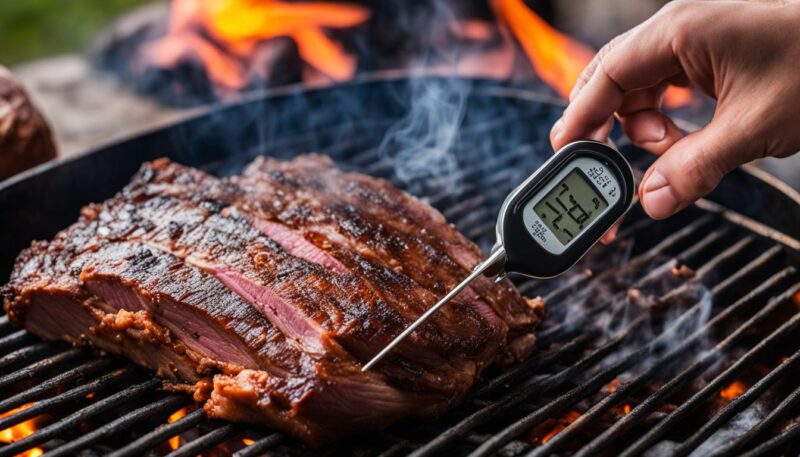
As I stand in front of the smoker, the smoky aroma filling the air, I recognize that one of the most critical stages of brisket preparation is deciding the best time to wrap brisket. This isn’t just about following a recipe; it’s about understanding the science behind the meat and how it reacts to heat and smoke. There’s an art to wrapping brisket, and it starts with paying close attention to its internal temperature and the visual cues brisket gives us.
The Importance of Monitoring Internal Temperature
Failure to wrap your brisket at the appropriate time can result in a less-than-optimal end product. It’s imperative to monitor the internal temperature closely to identify when the brisket reaches the stall. The range of 150° to 180°F (65.6° to 82.2°C) is when I know to prepare my wrap. By monitoring these numbers with a reliable thermometer, I ensure the cooking process continues smoothly, without the dreaded halt in temperature climb known as the stall.
Here’s the brisket internal temp-to-wrap chart I use during smoking:
| Temperature Range | Stage | Action |
|---|---|---|
| Below 150°F (65.6°C) | Early Smoking Phase | No wrapping needed |
| 150° to 160°F (65.6° to 71.1°C) | Approaching the Stall | Begin to consider wrapping |
| 160° to 180°F (71.1° to 82.2°C) | The Stall | Wrap the brisket |
| Above 180°F (82.2°C) | Post-Stall | Continue to cook wrapped |
Visual Cues for Brisket Readiness
The timing of the wrap isn’t solely dictated by temperature—eyeing the brisket bark for particular visual indicators is also a cornerstone of brisket readiness. I wait for the surface of the meat to reach a certain aesthetic: dark brown hues tinged with streaks of a deeper red, suggesting the bark has set correctly. This culmination of flavors in the crisp outer layer is a testament to a job well done and my cue that it’s wrapping time.
When I see that my brisket’s bark has taken on the appearance of a carefully charred, flavorful crust, I know it’s ready for its protective shroud.
While digital tools are invaluable, never undervalue the power of the human eye in gauging brisket readiness. A good bark forms a savory, smoky crust that is integral to that perfect brisket bite, and wrapping too early can rob it of this textural achievement.
In summary, wrapping your brisket should be a decision based on a comprehensive assessment of the meat’s internal temperature and the visual development of the bark. It’s a strategic mix of science and sensory evaluation. Every brisket smoker knows the anticipation of cutting into a perfectly cooked brisket and identifying these signs with precision brings us closer to that moment of BBQ bliss.
Why Wrap Your Brisket? The Benefits Explained
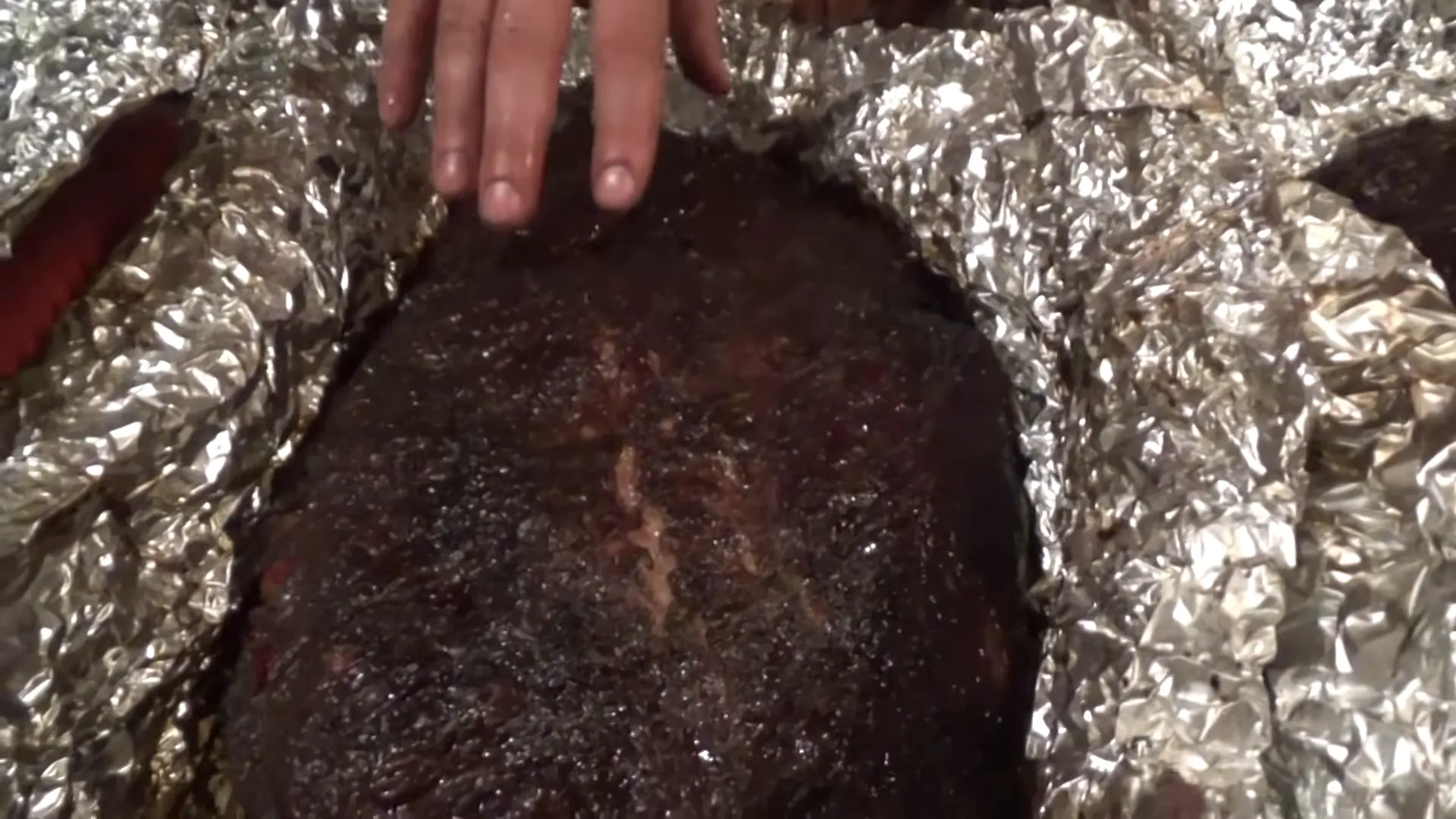
When I embark on a BBQ brisket endeavor, the question of why wrap your brisket invariably surfaces as a pivotal concern. It’s a technique steeped in tradition and reinforced by substantial benefits to the meat’s quality. Wrapping brisket, a practice as integral to barbecue as the spice rub itself comes with a host of advantages designed to elevate your brisket to heavenly heights of flavor and tenderness.
The decision to wrap is more than a passage; it’s a calculated move within the overarching strategy to perfect barbecue. Throughout my culinary ventures, I’ve noted key BBQ brisket tips that align with the benefits of wrapping brisket, each serving a critical purpose in the journey from raw to rave-worthy.
Wrapping brisket is like giving your meat a protective armor against the perils of the pit, ensuring it emerges victorious in taste and texture.
But, what are these touted benefits, and how can they transform your brisket experience? Let’s unwrap the layers of advantage that come with this BBQ-sage wisdom.
- Accelerates the cooking process by overcoming the stall, a period during which the brisket’s internal temperature plateaus, thereby reducing the overall cooking time.
- Maintains optimal moisture levels within the brisket, trapping steam and preventing the meat from drying out during prolonged exposure to heat.
- Provides a shield against excessive smoke, thereby mitigating the risk of imparting a bitter flavor and ensuring a balanced, smoky profile adaptable to a variety of taste preferences.
- Secures the brisket’s precious juices within, allowing for an invaluable resting period post-cooking where liquids evenly redistribute for an enhanced, juicy bite.
These advantages are not just theoretical; they are the product of countless smoking sessions and shared experiences with pitmasters around the nation. To further illustrate the pragmatic upside, consider the following comparative insights into the impact of wrapping brisket:
| Aspect | Unwrapped Brisket | Wrapped Brisket |
|---|---|---|
| Cook Time | Longer due to stall | Reduced, wrapping mitigates stall duration |
| Moisture | Higher risk of drying out | Retains moisture, stays juicy |
| Smoke Flavor | Potential for bitterness from overexposure | Balanced smoke profile, no over-smoking |
| Post-Cook Rest | Requires careful handling to retain juices | Conveniently pre-wrapped for even distribution of juices |
As you can see, the choice to wrap brisket is multifaceted, each facet aimed squarely at enhancing the result. By arming yourself with these brisket wrapping benefits, you place yourself in a position not just to cook, but to craft a BBQ masterpiece. So, the next time you’re huddled around the smoker, contemplating the brisket before you, remember: to wrap is to respect the brisket’s journey through fire and smoke, nurturing it to its most flavorful potential.
The Stall Phenomenon: What It Is and Its Impact
My dedication to the art of smoking brisket has led me to a deep understanding of the stall, a naturally occurring hurdle in the smoking process. The brisket stall phenomenon manifests when the internal temperature of the brisket hits a prolonged plateau. Despite a maintained external heat source, the temperature refuses to rise. This paradoxical event baffles many first-time smokers, leading to unnecessary alarm and often misguided responses.
During the stall, the brisket appears to defy the laws of cooking—the heat is steady, but the meat’s internal rhythm stalls, requiring patience and comprehension to navigate.
To demystify the stall, it is essential to realize that it is a natural cooling mechanism within the brisket. As the brisket’s internal temperature climbs, moisture within it travels to the surface, and as this moisture evaporates, it cools the meat’s exterior, counterbalancing the smoker’s heat. This process results in the brisket’s temperature hitting a standstill.
Understanding this, we can appreciate the impact of the stall on brisket: it is a crucial period that, if handled correctly, helps to render fat and connective tissues, leading to tender and flavorful meat. However, if mismanaged by increasing the smoker’s heat in a panic, it may only serve to dry out the brisket and toughen the protein fibers.
Learners in BBQ craft often ask me about the timing of the stall. The truth is, it’s not on the clock—it’s ingrained in the brisket’s interaction with heat and moisture. Here’s a table summarizing the approximate temperature range where you can expect the stall to occur, and possible measures to take:
| Temperature Range | Corresponding Action | Expected Duration |
|---|---|---|
| 150° to 160°F (65.6° to 71.1°C) | Monitor closely for stall | Varies |
| 160° to 170°F (71.1° to 76.7°C) | Stall likely begins | 1-3 hours |
| 170° to 180°F (76.7° to 82.2°C) | Stall in full effect; consider wrapping | 1-3 hours |
When faced with the brisket stall phenomenon, I advise embracing the smoking process in its entirety. Let the stall unfold naturally, and use the opportunity to solidify your bark until you’re pleased with its formation. Wrapping the brisket at this juncture aids in pushing through the stall while preserving the meat’s succulent nature and the bark’s robust flavor.
Knowledge of the stall and how to manage it is not optional; it’s as fundamental to barbecue mastery as the wood you choose or the rub you apply. In every successful BBQ brisket, there’s an untold story of a smoker, the stall, and the strategic decisions that led to victory.
Choosing Your Wrapping Material: Foil vs. Butcher Paper
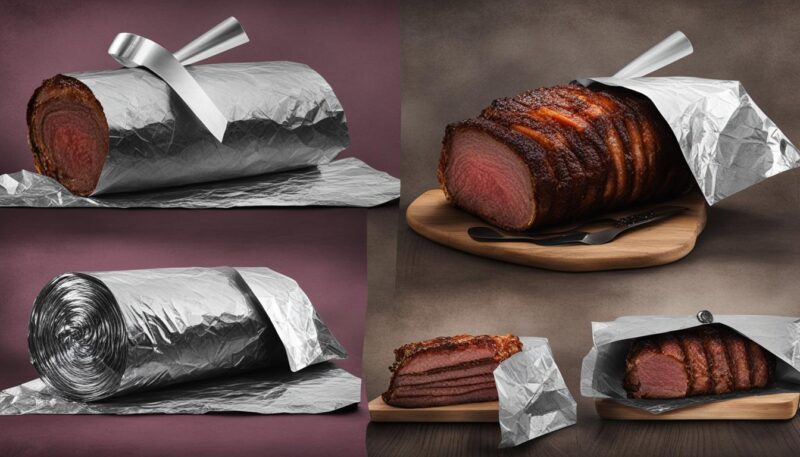
When it comes to locking in the flavors and textures of a perfectly smoked brisket, the material you choose to wrap with can have a considerable impact. In my pursuit of BBQ excellence, I’ve experimented extensively with both aluminum foil and butcher paper, often referred to as the Texas Crutch and traditional brisket wrapping, respectively. Each has its place in the craft of creating an exquisite brisket.
The ‘Texas Crutch’: Wrapping Brisket in Foil
Employing the Texas Crutch involves wrapping brisket in foil, a technique well-regarded for its effectiveness in overcoming the stall. Aluminum foil for brisket is a staple in many smokers’ arsenals due to its availability and ability to seal in moisture, quickly ushering the brisket through the temperature plateau.
By creating a nearly impermeable barrier, the foil reflects heat and fast-tracks the cooking process—yet, caution is advised as it may soften the highly prized bark.
| Characteristic | Aluminum Foil |
|---|---|
| Moisture Retention | Excellent |
| Bark Texture | At risk of becoming soggy if not monitored |
| Heat Reflection | Helps prevent overcooking |
| Accessibility | High |
Although wrapping brisket in foil is favored by many, it’s vital to manage the timing and tightness of the wrap to preserve the integrity of the bark. A delicate balance that merits both attention and skill.
Embracing Tradition: The Case for Butcher Paper
Traditionalists often favor butcher paper for brisket, lauding its ability to protect the meat during the stall while still letting it ‘breathe.’
In particular, pink butcher paper represents a sweet spot between the completely sealed environment created by foil and the full exposure of unwrapped meat. While it doesn’t reflect heat as efficiently, this porous material champions the development of a firm bark, embodying the very essence of BBQ artistry.
| Characteristic | Pink Butcher Paper |
|---|---|
| Moisture Retention | Moderate, allows meat to breathe |
| Bark Texture | Maintains firmness better than foil |
| Traditional Appeal | Strong, endorsed by iconic pitmasters |
| Availability | Less common than foil in household kitchens |
The use of pink butcher paper resonates with those who adhere to tried-and-true BBQ methods while still appealing to modern sensibilities focused on texture and authenticity. It’s a wrapping medium that embraces tradition without shunning innovation.
In conclusion, the decision between using foil or butcher paper to wrap your brisket hinges on a variety of factors, including desired moisture level, bark texture preference, and traditional values. As for me, I appreciate the virtues of both materials and select them on a case-by-case basis, depending on what each particular brisket calls for. This discerning approach is what sets apart a satisfactory brisket from one that’s memorably sublime.
Mastering Brisket Wrapping Techniques
When it comes to creating that impeccably succulent brisket, mastering brisket wrapping is as crucial as selecting the right cut of meat or the perfect spice blend. Throughout my experiences, I’ve pinpointed the significance of “how to wrap your brisket” with precision—a transformative step transforming good barbecue into greatness.
The subtleties of brisket wrapping techniques are many, but they boil down to a fundamental truth: creating an environment that imbues the meat with moisture and tenderness without compromising the much-desired bark.
Just as a painter requires a clean canvas, the barbecue enthusiast needs a perfect piece of brisket—a task achieved through the art of wrapping.
- I ensure I’m working with enough wrapping material, generally aiming for a length four and a half times the width of the brisket. This ensures I have ample material to create a snug wrap.
- An overlapping layer of wide aluminum foil or butcher paper is laid out, ready to become the brisket’s cocoon during its crucial cooking phase.
- Before the brisket makes its grand entrance onto this stage, I spritz the surface with a moist mixture. This could be as simple as water a fragrant combination of apple cider vinegar and water, or even a little beef tallow.
- The brisket, poised fat side up, is then placed onto the prepped surface, and the wrapping begins. I’m careful to encase it tightly, ensuring no steam pockets form which could dampen the bark’s integrity. It’s reminiscent of tucking in a cherished treasure.
The following table provides an at-a-glance guide for wrapping your brisket:
| Step | Detail | Tips for Success |
|---|---|---|
| 1. Preparation | Cut material to size | Measure the length to be 4.5 times the width of the brisket |
| 2. Layering | Overlap foil or paper | Ensure 50% overlap for strength and coverage |
| 3. Spritzing | Moisture application | 50/50 mix of water and vinegar, or beef tallow |
| 4. Wrapping | Tight but careful encasement | Avoid creating steam pockets; wrap brisket like a cherished gift |
The art of wrapping is not one that can be rushed. It demands respect for the process and a meticulous approach. Once the brisket is ensconced within its wrapping, the transformative journey towards tender, flavor-packed excellence continues within the smoker’s warm embrace.
In conclusion, whether you choose foil or butcher paper, the method remains relatively similar. Mastery comes with understanding how each material interacts with the meat and how each affects the outcome. Practicing these brisket wrapping techniques will allow even a novice to produce results that mirror the expertise of seasoned pitmasters.
How Wrapping Affects Cooking Time and Temperature
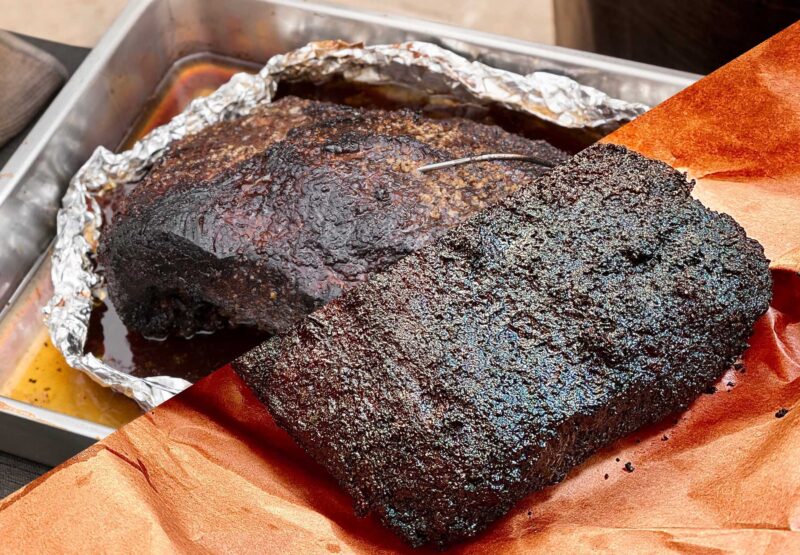
One of the most transformative brisket wrapping effects is its influence on cooking time and cooking temperature. Through my smoking journeys, I’ve come to appreciate brisket’s sensitivity to these two factors and how they can be skillfully managed through the wrapping. Whether I’m aiming for a quick cook or a leisurely smoke, understanding these effects is paramount.
The act of wrapping brisket serves as a means to envelop the meat in a stable microclimate that can break through the infamous stall, where the internal temperature plateaus due to evaporative cooling. By creating this enclosed environment, we can nudge the internal temperature upwards more predictably and efficiently.
Wrapping brisket is a method I employ to ensure the meat breaks through the stall, achieving a harmonious balance of heat that carries it to its final desired tenderness.
Let’s discuss specifically how wrapping influences cooking time:
- Unwrapped brisket may take longer to cook, as it’s exposed to fluctuating temperatures and the evaporative cooling effect.
- Once wrapped, the brisket moves through the stall phase quickly, reducing overall cooking time.
Now, examining the impact on cooking temperature:
- Wrapping helps maintain a consistent cooking temperature around the brisket, mitigating the risks of temperature spikes or dips.
- This consistent environment is critical for ensuring the brisket reaches an internal temperature conducive to proper collagen breakdown—203° to 205°F (95° to 96.1°C).
Here is a table contrasting the experiences with and without wrapping:
| Condition | Cooking Time | Cooking Temperature Stability | Optimal Tenderness Temperature |
|---|---|---|---|
| Unwrapped Brisket | Longer, affected by the stall | Variable, prone to fluctuations | Challenging to reach 203° to 205°F |
| Wrapped Brisket | Shorter, stall mitigated | Stable, less affected by external conditions | Easier to achieve 203° to 205°F |
To wrap up, the advantages of adapting your brisket cook with a well-timed wrap are clear. The controlled environment provided by wrapping, whether in foil or butcher paper, not only diminishes cooking time but also promotes even temperature distribution. By employing these wrapping techniques, you can ensure that your brisket reaches the perfect internal temperature for that fall-apart tenderness every pitmaster aspires to achieve.
Maintaining Moisture and Flavor: Tips for a Juicy Brisket
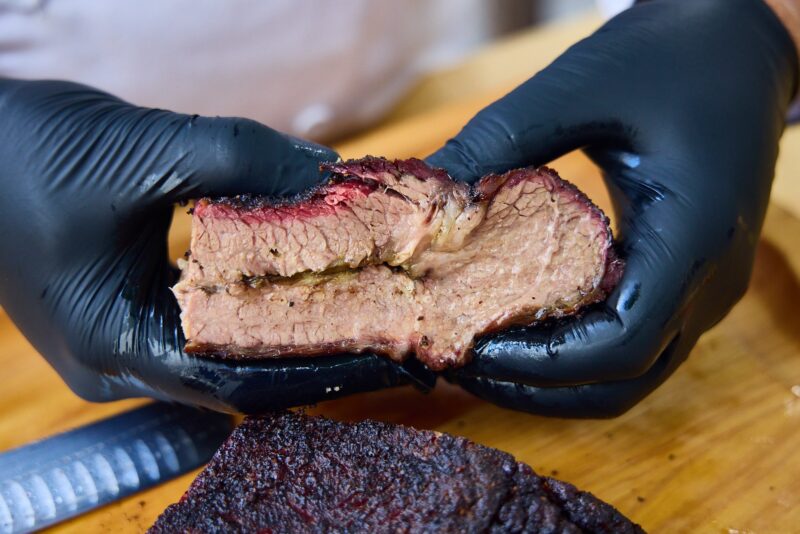
As I delve deeper into the world of barbecue, the phrase I hear most often is the importance of “maintaining brisket moisture”. It’s a pivotal factor, one that can mean the difference between a passable brisket and an unforgettable one. It’s not just about locking in juices; it’s about fostering a harmony of flavors that resonate with every bite. That’s why I follow a few golden brisket flavor tips to ensure I’m always serving up a juicy brisket.
It begins with the wrap. Wrapping might seem like a simple task, but it’s a critical technique. The right wrap not only maintains moisture but also allows the brisket to continue cooking in its own savory juices, concentrating the flavors within.
Remember, wrapping isn’t just a step; it’s a commitment to the quality of your final product.
But wrapping isn’t where the job ends. A low and slow cooking method is essential to avoid drying out the meat. Gentle heat encourages the collagen in the brisket to convert into gelatin, which imbues the meat with a melting tenderness and retains its inherent moisture.
- Proper wrapping to keep the brisket moist and flavorful.
- Gentle heat to render the fat without drying the meat.
Even with these measures, monitoring internal temperatures is crucial. Here’s where a reliable probe thermometer comes into play, offering peace of mind and precision as the brisket smokes.
Finally, after the cooking process, I let the brisket rest in its wrap. This isn’t time lost; it’s an essential stage where the juices redistribute throughout the meat, ensuring every slice is as juicy and flavorful as possible.
- Wait with patience during the resting period post-cooking for optimal distribution of flavors and juices.
- Monitor the brisket with a probe thermometer to prevent overcooking.
| Wrapping Phase | Specific Action | Benefits |
|---|---|---|
| Initial Wrap | Wrap brisket at the correct time with the right material. | Locks in steam and spices, setting the stage for a juicy, flavorful brisket. |
| During Cooking | Maintain a consistent low temperature. | Gentle cooking ensures brisket stays moist, allowing connective tissue to break down properly. |
| Temperature Monitoring | Use a probe thermometer to check internal temp. | Prevents overcooking and drying out, and maintains the right level of doneness. |
| Resting Period | Let wrapped brisket rest post-cooking. | Allows juices and flavors to redistribute for a perfectly moist and succulent texture. |
In summary, bringing out the best in your brisket is a multifaceted process where monitoring, patience, and understanding of your meat’s needs go hand in hand. By adhering to these tips and embracing the art of slow cooking, you set yourself up for a beautifully moist and exceptionally flavored brisket every time.
Frequently Asked Questions (FAQ)
Why is wrapping your brisket important during smoking?
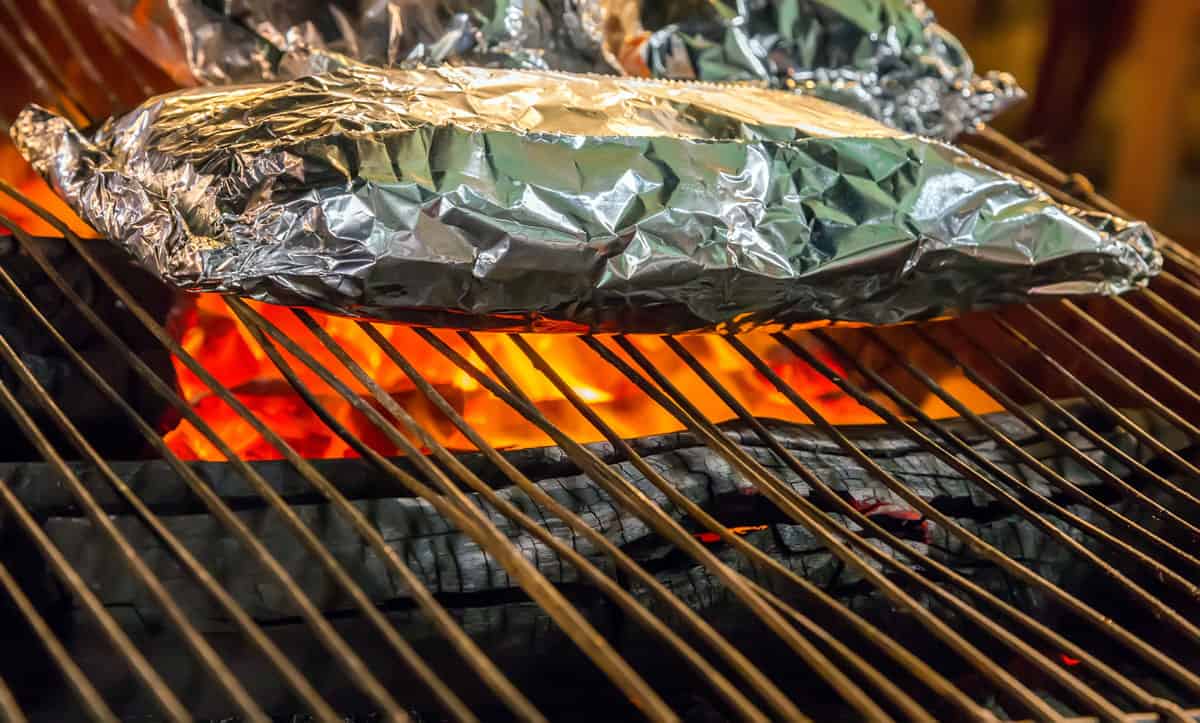
Wrapping your brisket is crucial because it helps to combat the stall, retains moisture, speeds up cooking, prevents over-smoking, ensures even cooking, and helps preserve the quality of the bark. It’s a technique that contributes significantly to the tenderness and flavor of the final product.
What is the best time to wrap your brisket?
The best time to wrap your brisket is typically when the internal temperature reaches a plateau between 150° to 180°F. At this point, the stall phase is occurring, and wrapping can help push through this stage. Also, look for a firm and dark crust on the meat which indicates good bark development and readiness for wrapping.
What are the visual cues to look for before wrapping a brisket?
Before wrapping a brisket, look for a bark that is firm to the touch, along with a dark brown or deep dark red coloration. These visual cues suggest that the brisket’s surface moisture has sufficiently evaporated to form a crust, implying the right moment to wrap.
How does the ‘Texas Crutch’ method work for wrapping brisket?
The ‘Texas Crutch’ involves wrapping the brisket in aluminum foil. The method works by creating a tight seal that traps moisture and heat, helping to accelerate the cooking process through the stall phase. However, it’s important to wrap it properly to avoid ending up with a soft bark.
Why might someone choose butcher paper over foil for wrapping brisket?
Butcher paper, especially untreated pink butcher paper, is chosen over the foil for its breathability, which can better preserve the texture of the bark while still protecting the brisket through the stall. It retains less steam, preventing the bark from becoming soggy, and can contribute to a more traditional smoky flavor and crusty bark.
Can you provide a step-by-step guide on how to wrap a brisket?
To wrap a brisket, start by cutting a large piece of foil or butcher paper, about four and a half times longer than the width of the brisket. Lay it flat, spritz the paper or foil with a moisture mixture if desired, and place the brisket on top. Proceed to wrap it tightly, ensuring the layer overlaps and eliminates air pockets that could steam and soften the bark.
How does wrapping brisket impact the cooking time and temperature?
Wrapping brisket can significantly impact the smoking time by speeding up the process once the meat has reached the stall phase. By creating an insulated environment, the brisket maintains a more consistent temperature and cooks more evenly, allowing it to reach the ideal internal temperature of 203° to 205°F more efficiently.
What are some tips for preserving moisture and flavor while cooking brisket?
To preserve moisture and flavor, wrap the brisket at the appropriate time during the stall, use low and gentle heat to prevent drying, monitor the internal temperature closely with a probe thermometer, and allow the brisket to rest while wrapped post-cooking to let the juices redistribute for a juicy and flavorful brisket.
Conclusion
Throughout this guide, my aim was to empower smokers with a thorough summary brisket wrapping guide to execute a successful BBQ brisket. The path to perfection in brisket smoking delicately intertwines patience, technique, and an understanding of the meat’s biology. From the early stages of the stall to the final rest, wrapping your brisket is more than tradition; it’s a fundamental element in achieving barbecue greatness. By recognizing visual cues indicating readiness, grasping the nuances of internal temperature, and selecting the ideal wrapping medium, we take control of the elements that lead to a show-stopping brisket.
As the curtains draw on our brisket wrapping journey, we see that each choice made—from the type of wrap to the timing—is a stitch in the tapestry of BBQ mastery. Whether you choose the heat-reflecting embrace of foil or the breathable hug of butcher paper, these decisions culminate in a moist, tender brisket with a bark that sings with flavor. Indeed, the pressing question of when to wrap your brisket. now has a clear answer: during the stall, and always informed by the meat’s color and texture.
In conclusion, this wrapping brisket conclusion reflects both science and soul, a homage to the art of BBQ. As you venture forth to smoke your brisket, remember the principles encapsulated in this guide. By doing so, you’ll forge not just a meal, but a memory, imparting a legacy of flavor that lingers long after the smoke has cleared.

